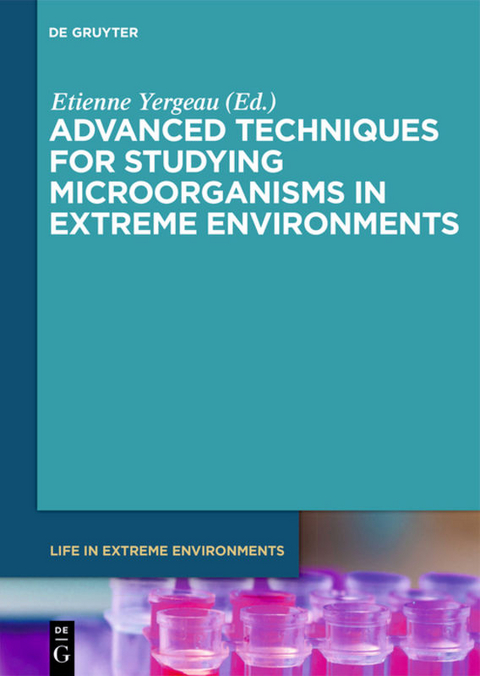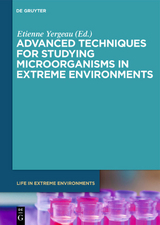Advanced Techniques for Studying Microorganisms in Extreme Environments
De Gruyter (Verlag)
978-3-11-052464-2 (ISBN)
Book Review:
Microbial Life of the Deep Biosphere (2014) edited by Jens Kallmeyer and Dirk Wagner, Walter de Gruyer GmbH, Berlin/Boston
Thomas L. Kieft
New Mexico Tech
Subseafloor sediments and crust as well as the groundwater environments beneath the continents comprise something of a last frontier among the Earth's ecosystems in terms of scientific exploration and discovery. Early reports of microbes in deep Earth environments, e.g., John Parkes' meticulous microscopic counts of microbes in subseafloor sediments, were often met with skepticism that these microbes were merely drilling contaminants or dead cells; but now, happily, deep life studies have matured such that the existence of the deep biosphere is widely accepted. The Ocean Drilling Program and its successors, currently the International Ocean Discovery Program (IODP), have devoted considerable resources to biological aspects of subseafloor environs; the International Continental Scientific Drilling Program and various other initiatives, including probes of the deep Earth via mines and underground research labs, have made similar progress in exploring and understanding the highly varied on-shore groundwater environments. Expanded drilling opportunities and biotechnological advances have enabled clear demonstrations that deep microbes are phylogenetically and metabolically diverse and that they're alive and well and actively contribute to biogeochemical cycling. Given the recent progress in deep life studies, the publication of Microbial Life of the Deep Biosphere, edited by Jens Kallmeyer and Dirk Wagner, as the first volume in a series on Life in Extreme Environments, is extremely timely. The book can serve as an introduction to the deep biosphere for neophytes or as an update on the latest findings for those who are already knowledgeable in the field.
The book opens with an update on the past 10 years of IODP seafloor sediment studies by Parkes and colleagues and continues to other subsurface habitats with chapters on basaltic ocean crust by Jennifer Biddle and coauthors and continental hard rock environments by Karsten Pedersen. Parkes' more recent counts continue to show a logarithmic decrease in microbial abundance with depth; he and coauthors also review recent findings of a dominant core group of microbial taxa that are widespread in marine sediments. As a whole, the book focuses more attention on marine than continental systems, but Pedersen's chapter and also later chapters on petroleum reservoirs by Bernard Ollivier and coauthors, on carbon sequestration and geothermal energy development by Masal Alawi, and on Mars (and Earth analogs) by Charles Cockell give a good picture of the geologically and microbiologically varied subterranean habitats. Specialized groups of microbes to which chapters are devoted are the Archaea (Andreas Teske) and fungi, which some still consider to be artifacts or merely buried, dead cells, but Virginia Edgecomb and coauthors present strong arguments for their being indigenous and active, similar to their prokaryotic counterparts. There's growing evidence for the importance of viruses as controllers of prokaryotic biomass and as vectors for gene transfer (touched on briefly by Pedersen), so this reviewer would like to have seen a chapter devoted to them. Technical issues addressed in separate chapters include the challenges of cultivating subsurface microbes, a comparison of methods for quantifying subsurface microbes by Karen Lloyd, and nanoSIMS (secondary ion mass spectrometry) and other approaches for querying the activities of single cells, by Yukio Marono and coauthors. As Morono points out, the potential for combining these methods, e.g., single cell genomics with nanoSIMS is especially exciting. Final chapters are devoted to quantitative, ecosystem-level issues of basin-scale modeling of microbial processes in petroleum hydrocarbon reservoirs (Rolando di Primio), estimating rates of catabolism of various functional groups in the subsurface based on Gibbs free energy calculations (Doug LaRowe and Jan Amend), and quantidying rates of metabolism and carbon turnover in subsurface sediments where the available energy may only barely meet maintenance requirements (Hans Røy).
In summary, Kallmeyer and Wagner recruited active researchers, each with expertise in an important area of subsurface microbiology, to write richly referenced overview chapters. Each details the current state of knowledge and most also identify major gaps in our understanding and directions for future research. Microbial Life of the Deep Biosphere is a fine addition to a university library or the personal library of a geologist, biologist, naturalist, or any combination thereof.
| Erscheinungsdatum | 25.10.2019 |
|---|---|
| Reihe/Serie | Life in Extreme Environments ; 8 |
| Zusatzinfo | 2 b/w and 14 col. ill. |
| Verlagsort | Berlin/Boston |
| Sprache | englisch |
| Maße | 170 x 240 mm |
| Gewicht | 581 g |
| Themenwelt | Geisteswissenschaften ► Religion / Theologie ► Judentum |
| Naturwissenschaften ► Biologie ► Mikrobiologie / Immunologie | |
| Schlagworte | Environmental Microbiology • extremophiles • genomics • Molecular Biology |
| ISBN-10 | 3-11-052464-3 / 3110524643 |
| ISBN-13 | 978-3-11-052464-2 / 9783110524642 |
| Zustand | Neuware |
| Informationen gemäß Produktsicherheitsverordnung (GPSR) | |
| Haben Sie eine Frage zum Produkt? |
aus dem Bereich




